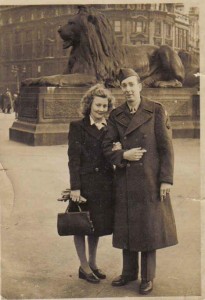A sugar girl turned GI Bride
Posted By GI Brides ~ 11th September 2013
When we posted a notice on the website for our book The Sugar Girls calling for stories of British women who had become GI Brides, we never expected to find a woman who was both – and yet that was the case of Frances Pelling. Her daughter Lynn contacted us to tell us her story.
Frances was born in 1923 and grew up on Eastwood Road in Silvertown, a stone’s throw from Tate & Lyle’s Plaistow Wharf Refinery. At the age of fourteen she left school and took a job as a sugar packer on the Hesser Floor. After her father had walked out on the family, she had been raised by her mother, who was deaf, and her elderly grandfather, and as an only child she was the main breadwinner of the family.
During the war, the family would gather at a shelter in Lyle Park, although Frances always worried that being deaf her mother would not be able to hear the sirens. The first she would know of the bombs falling was the vibrations that she could feel – one time she got up to answer the door convinced that someone was knocking, only to find it was a raid.
Frances met her GI husband, Richard Ross, at the roller-skating rink at Forest Gate. A corporal in the US Army, he was based at the docks, where he helped supervise the ships that were bringing in supplies for the Americans. At the skating rink, Frances felt sorry for him, since he seemed to be spending more time on the floor than he did skating around. They got talking, and arranged to see each other again. Soon they were dancing together at American Red Cross clubs and playing darts in the local pubs, as well as walking for miles around and ending up on a bench in Lyle Park.

Frances and Richard in Trafalgar Square
In less than a year Frances and Richard were married, in a Baptist church in Plaistow. Strangely, she had been warned that she would marry a foreigner – by a tea leaf reader she had visited a few months earlier. The woman had told her she would move to a different country, never see her mother again, and almost die in childbirth. Frances was so terrified she vowed never to see a fortune teller again.
Richard was from Brooklyn and when Frances told her mother that she would be leaving Silvertown to live with him in New York, the poor woman was devastated – as a deaf single mother she had always relied on her daughter’s help and support and she was worried about how she would cope on her own.
When the war ended, Richard was shipped home and Frances awaited passage as a war bride. But she was already pregnant, and gave birth to baby Lynn before she could be reunited with her husband. She developed pre-eclampsia and was seriously ill for several weeks, so Lynn went to live with her grandmother.
It was almost a year later that Frances finally made her way to the United States, on a liberty ship, the George Washington Goethals. Like many women, she was upset at the way she was treated by the American authorities, who were often suspicious that GI brides, particularly those from poorer backgrounds, were using marriage as a ticket to a richer country. ‘I was made to feel like a tramp’, she later told her family.
It was a stormy crossing, and Frances was badly seasick. At one point the ship rocked so violently that her daughter’s crib broke loose of its fixings and careened across the deck and into a bulkhead, leaving the baby with a nasty cut to her chin. Frances was filled with relief to finally arrive at the pier in New York, where Richard came running up the gangway with a beautiful cocker spaniel puppy in his arms. (His mother had given him some money to buy a new suit for the occasion, but he had decided that a new dog was much more suitable!)
Frances and Richard went to live with his mother in her small apartment in Brooklyn. It was a difficult time for Frances – Mrs Ross felt that her son had married beneath himself and largely ignored her new daughter-in-law, although fortunately she adored baby Lynn. It was a relief when they were able to move out and go to live with Richard’s grandmother in Milford, Connecticut, in a house just a block away from the beach.
When the old lady died, Richard and Frances remained in her house, and they stayed in Connecticut for the next fifty years. Richard got a job in the paint department of Sears Roebuck, where he worked his way up to become manager. When he retired, the couple moved to Florida.
At first Frances found it hard to adjust to life in America, and she felt that people she met were so fascinated by her English accent that they didn’t bother to listen to what she was saying. She was shocked when she saw her first teabag and avoided ‘foreign’ dishes such as pizza and spaghetti. But in time, she found a group of British women in Milford, the British-American Club, which became one of the focal points of her life.
Although Frances grew to enjoy life in America, her great regret was for her deaf mother, left behind in England. She wrote to her regularly, and sent pictures every few months, but she was unable to travel home to visit until the 1950s, when her mother was dying. For the rest of her life, Frances felt troubled by guilt at having left her mother behind when she became a GI bride. But she had come to love life in America, and was happily married to Richard for 64 years.
Frances died in 2009 at the age of 86. Her relatives brought some of her ashes back to England and scattered them in Lyle Park.





Fascinating to read about my grandmothers sister..my own mum, the eldest in her family, born in 1912 had a similar background, worked at Lyles factory, almost lost an arm due to an industrial accident there. Of course by the outbreak of World War II she was married with four children and living in Tilbury, my dad working for the PLA and had duties as an air raid warden for a lot of the time. After the war the remaining six kids arrived, and I along with all my siblings have many happy memories of our grandmother, but only very sketchy details of her sister. Which makes this article all the more interesting to read.